Getting ready for your year abroad
The big day has finally come. You thought about it for quite some time. It wasn’t easy. You had many doubts and quite some fears but, finally, you made up your mind and decided to spend a year abroad. It might be that you got accepted at the Erasmus program and you are going to study at that university you always dreamed of. Maybe one of your friends spent a year in Australia with the Work and Holiday Visa and, after listening to his/her stories, you felt like you also wanted to have a break from your job and try for yourself that enriching and incredible experience. It can also be that you just finished college and, before getting into the darkness of the working world, you decided to treat yourself by travelling around the world during your gap year. But, what to pack for a year abroad?
Regardless of the reasons that made you decide to leave your comfort zone and jump into the unknown for more than a few months, the truth is that, you too, will have to face the scary and bothersome process of deciding what to pack for a year abroad. In the last few years I’ve been through that process many times and, I want to think I’ve learnt from my mistakes and become better at packing light and putting inside my backpack just what I really need. When I left my working life in Barcelona and arrived in Australia, I did it with two big suitcases. Yes, I too was a novice at that time. The year went alright and travelling with two big suitcases wasn’t a big deal. But, that was just because I spent several months living in cities and, when I travelled, I did it by car.
Learn to say goodbye to what you don’t need
When the time to leave Australia came, as I was planning my trip in Southeast Asia for 3 months (Indonesia, Philippines and Myanmar), I realized I had a problem. A big one. Or, better said, two big ones. I was going to spend 10 days in Bali travelling with a moto. Then, I decided to climb Kawah Ijen and to hike to Mount Bromo. If that wasn’t enough, I also adventured myself into a 2D1N trek in the jungle of Ketambe to try to spot some orangutans and went diving in Pulau Weh and Komodo National Park.
Can you dare to imagine yourself doing all that carrying 2 big suitcases? The answer is “no” (I hope lol). So, to fix my first problem I had to send the 2 big suitcases back home and, as you might imagine, it wasn’t cheap, at all. I sent the suitcases full of clothes and things I didn’t need. Until that life-changing day, I was unaware of all the needless things I was carrying with me all the time. For example, regardless of having quite a few clothing options, the truth is that, most of the time, I was wearing the same clothes. Have you thought about it yourself?
I did quite a few different jobs in Australia: kitchen hand in Sydney, professional apple picker in Mooroopna and bartending in Cairns. For every job I used different clothes and, obviously, I didn’t have those clothes with me when I arrived in Australia. So, what did I do? I just bought them, used them and, when I didn’t need them anymore, depending on how worn out they were, I either donated them or threw them away.
Pack light, pack smart
Most of the days I was working, which meant, I was wearing the same clothes most of the time. When I wasn’t working, I just wore a few different clothes a day, depending on whether I was just chilling at home or smashing a club at night. Can you see where I’m trying to get to? I didn’t need most of the clothes I had with me! Surprised? I can understand it, since most of us live in consumerism societies where using something more than once seems to be a crime.
Once you become aware of how much needless stuff you have, you are already on the good path to “salvation”. Letting go of things is not an easy thing. Nobody said it was easy 🎵. They mean something to you and you feel like you “need” them all. But, once again, you don’t need them all, you just need what you need, depending on where you are at the moment or where you are planning to go. Another example: are you sure you need 5 pairs of trousers, 20 pairs of shirts and 10 pairs of shoes? I’ll be cruel now: “no”.
No, you don’t need all that. You can wash your clothes regardless of where you are. When I was lost in Sumatra in the middle of the jungle, even there, I could find some local laundries. And, if not, I would just wash the clothes myself. You can also buy new clothes when you really need them! For shoes, you might need one pair for hiking, one for running, another one for going out at night and one more for staying at home and/or going to the beach. That’s all. Of course, you might bring those lovely pair of high-heels you just bought, but don’t bring all ten of them 🙂 As parents tell their children: “all this is for your own good”. Believe me, you don’t want to be carrying 30 kilos of clothes on your back.
So, what to pack for a year abroad?
I’m assuming here that you are going abroad for a year. Thus, you are going to need winter and summer clothes. I’m also assuming that you will do a bit of hiking/trekking and that you like to go for a run or to the gym now and them. If you are just going on holidays for a few weeks and you know you are not going to move from the beach or the beach bar, then, you can take more summer clothes and more fashion shoes and forget about the winter clothes, for example.
Big backpack and waterproof cover
Firs things first: where are you going to put all your clothes, electronic devices and other accessories? In a backpack. Or, better said, in a 55 + 10 L backpack. As the name suggests, the 10 L are extra, optional. So, if you are not packing too many stuff, you might just need the 55 L. But, if you decide to buy that cool action figure in Japan or that beautiful hat in Australia, those 10 extra L will come in handy.
Other than the size, nowadays all the backpacks come with straps, hooks and other stuff that allow you to organize everything in a very tidy way. One last thing you might want to add to your big backpack is a waterproof cover. You can use it (obviously) to protect your clothes from rain but, also, to add certain clothes or items between the space of your backpack and the cover itself. Just as if it was a turtle’s shell 🐢.
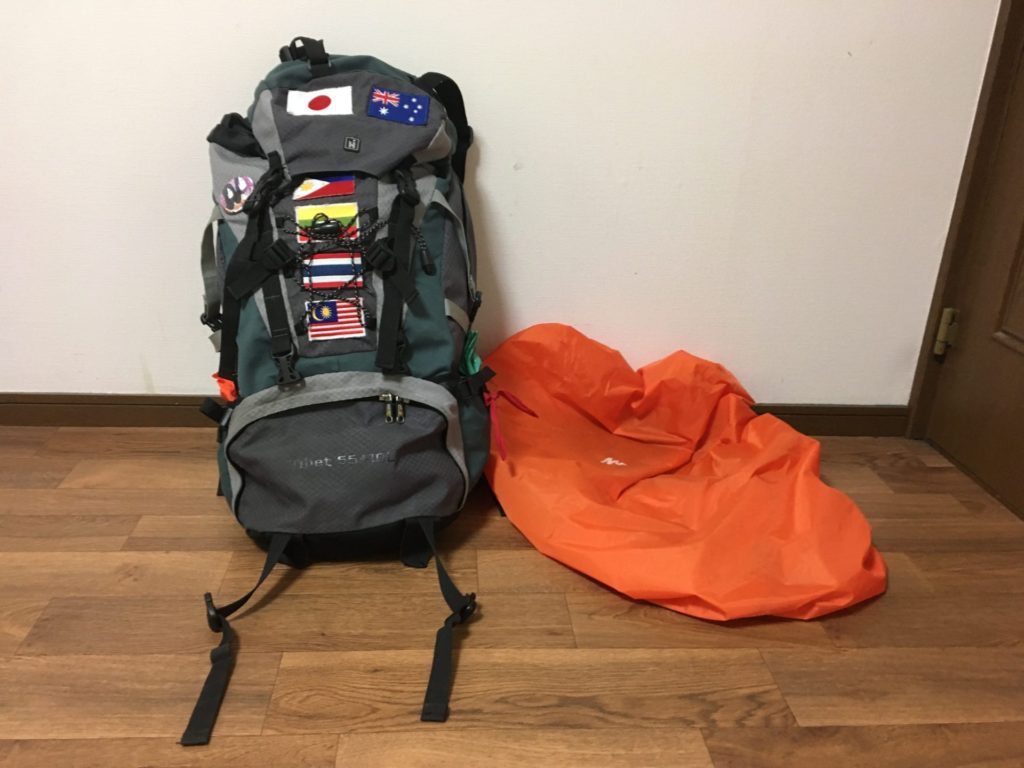
Carry-on backpack
You will use the big backpack to store all your clothes, shoes and your toiletry (to avoid having it thrown away when passing through the check control at the airport). What will you use the carry-on backpack for? For electronic devices, books and other fragile items. This one will be always with you, stuck to your heart (literally). Back in the day, most of the airline companies allowed you to travel with 10 kilos in your carry-on backpack. Now, the rules have changed (Capitalism, what did you expect?) and most of us are being restricted to 7 kilos. That’s why you are going to use your carry-on backpack (of around 20-25 L) just for your most valuable things.
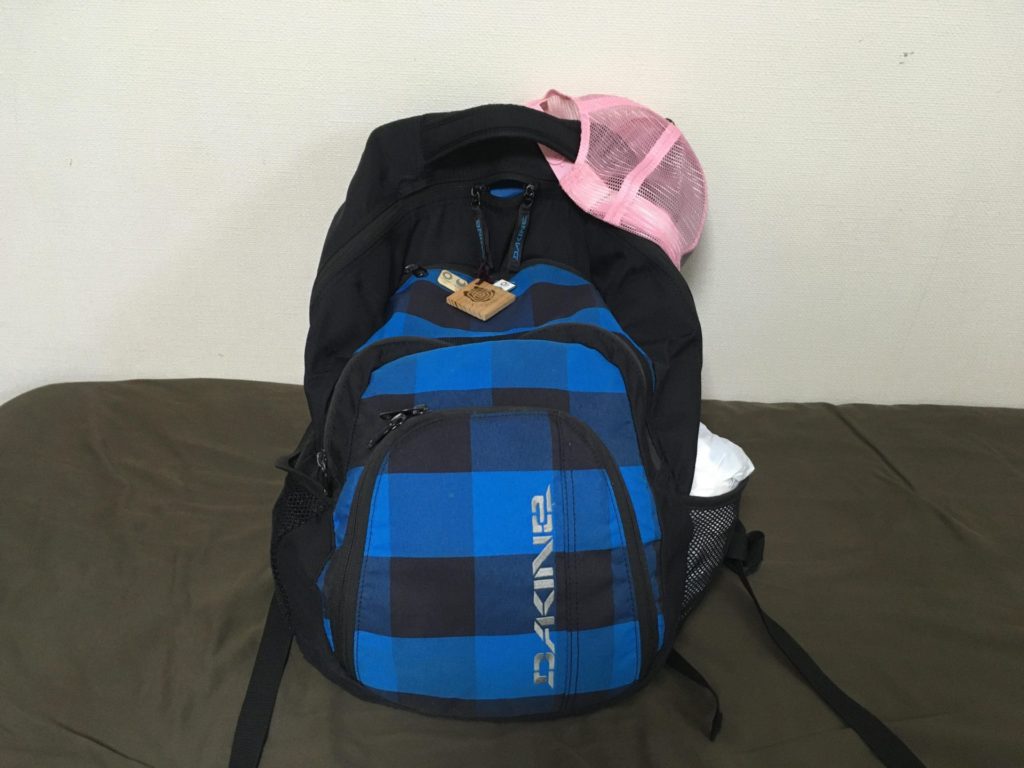
Electronic devices
Speaking about electronic devices, in my case, that makes 85% of the contents of my carry-on backpack. Because I’m into diving, I travel with a GoPro, which I bought right before leaving Australia. I also have a red and purple filters which I use when I dive deeper than 10 meters, so the quality of the image is still good. I also like to listen to music and, for that, a tiny but powerful speaker is a must. To write this blog, to watch anime or to just surf the web, I also travel with a light but fast and powerful Asus laptop. It’s been with me for 5 years now and it works like a charm :).
Depending on what part of the world I’m at, the voltage required to charge my electronic devices might not be the same. For that, a universal adapter is your best option! Last but not least… a drone! I recently bought the DJI Mavic Mini in Japan and I couldn’t be happier with it! It’s a model from 2019 but, regardless of the year it came to live, the quality of the video, the stability and, specially the weight (199 g with the Japanese battery), are awesome!
I must admit I was about to buy a Holy Stone model because it was cheaper but, after checking how shaky and unstable the videos were, I decided to buy the DJI. The 3-axis gimbal works like magic and, even if it is very windy, the image is super stable. Nowadays you can buy the DJI Mavic Mini 3 but, other than being quite expensive (at least for me), I felt that, being just a novice, I was good starting with the model form 2019. So far it is working perfectly!
One last item you are going to need at some point is an external hard drive. Even if you have the latest iPhone, at some point, you are likely to run out of memory. To that extend and to always have a backup of your videos, photos and important documents, you need an external hard drive. P.S: If you are like me and still have an old iPhone (mine is iPhone SE lol), your battery might not last that long. For that, you are also going to need a power bank 🙂

Winter clothes
Even if I’m going to a hot place or to a country during summer, I always have with me a pair of long pants and a long sleeve t-shirt. This t-shirt also happens to be a thermal one with the cleavage covering almost my whole neck. I still remember as if it was yesterday when I spent a night sleeping at the port of Banda Aceh. That night wasn’t a cold one, but there were plenty of mosquitos flying around my delicious body and, thanks to the long pants and the long sleeve t-shirt, I made it through the night.
Regardless of whether it is winter or autumn, I always have with me one or two hoddies. I just love that piece of clothing to the point that I think it is my favourite one :). Last but not least, I always travel with a winter jacket (if possible, waterproof) which protects me from the cold and sometimes also can become a comfy pillow.
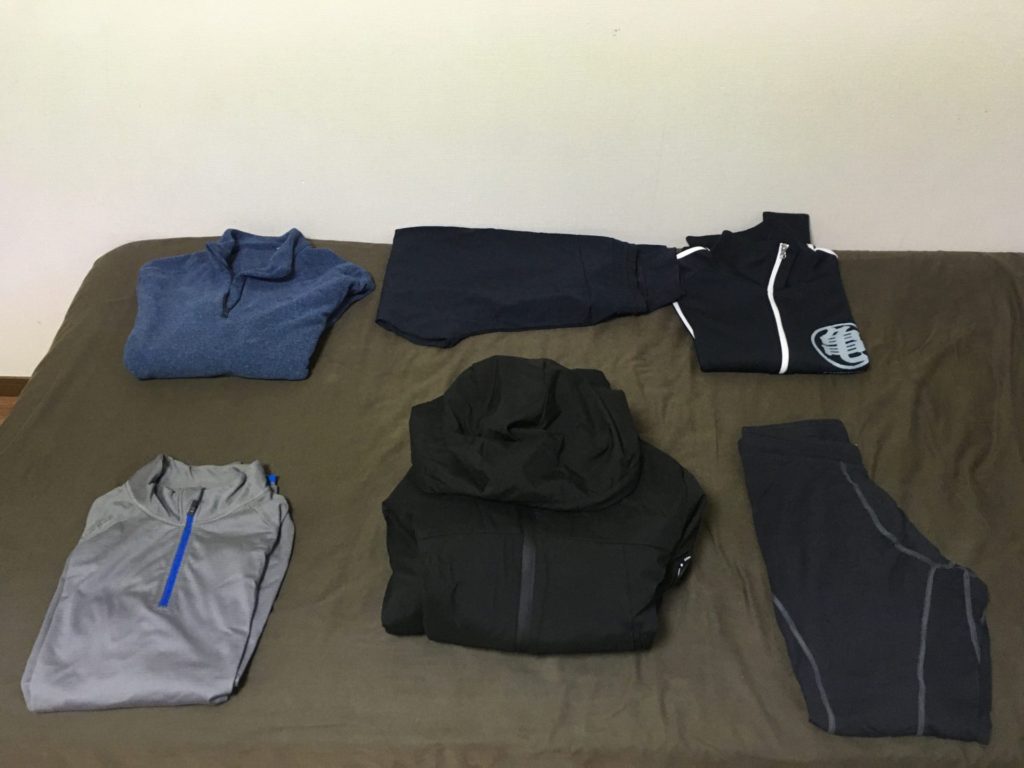
Summer clothes
From winter to summer, and from warm clothes to another favourite of mine: tank-top or, as my Argentinian friends call them in Spanish: “musculosas” (muscular) 😅. In the picture you can see I have four of them: two very thin ones that I bought while travelling in Southeast Asia and two basketball jerseys. They are very thin and occupy very little space so, for me, when you need to decided what to pack for a year abroad, they really are a must. Along with the upper wear, I always take two swimsuits with me when spending a year abroad, being Erasmus or Working Holiday. Last but not least, a cap. When you are going to the beach or to a techno festival, having one as cool as the Buu one will help you making friends 😜.

Shorts and trousers
Two trousers and two shorts. That’s all. You can see I actually have three shorts in the pictures… Why? Because I made a mistake 🤪. Yes, even those who’ve been in the travelling world for a very long time can also make some mistakes now and then lol. Being serious now, just think about it. Do you really need more than two and two?
Right now, as I’m writing this post, I’m in Tokyo. It’s very hot and humid here so, when I go out in the morning say, with the blue shorts, by the time I come back in the evening to take a shower and get ready for some Tokyo’s night, the blue ones are kind of sweaty, after being walking the whole day. That’s normal, specially when you are in summer in a country like Japan. But, fear not, because, after taking your shower you can just wear the green ones and, when you wake up next morning, you can wear the blue ones again and they’ll be just fine. P.S: If by any chance they are not, you just wash them!
The same applies to the long pants. It might be autumn or winter in the country you find yourself just now and, out of the blue, it starts pouring and you end up soaked to the bone. What do you do? You go home, let the jeans or trousers to dry and put on the other pair. As simple as that 😁.
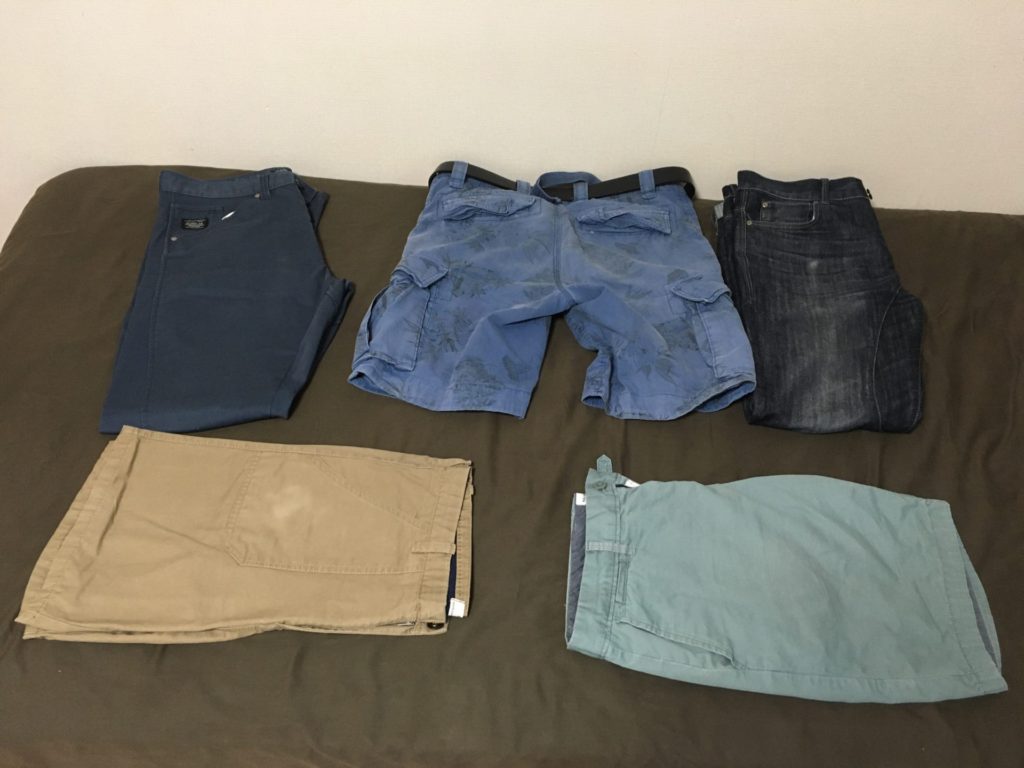
T-shirts and shirts
When it comes to clothes, what I pack the most is t-shirts. It is kind of obvious I guess but, I will state my reasons regardless. Before, I just said two shorts and two long pants are enough and I stated why. Why do you need more t-shirts? Because they are going to get dirtier, sweatier and smellier than the lower wear way faster. Also, while wearing the same shorts or long pants, you can change your upper wear to change your style. In the picture you can see I have two very cool shirts. The beige one I bought it in Myanmar, during the 3 weeks I spent travelling there. The one behind, the one with the olive tree branches, I bought it in Spain at Jack and Jones.
Then, I also brought with me two sports t-shirts that I use when going for a run or doing some work out and five regular t-shirts, which I wear when going sightseeing, on a date or when going with my friends to drink a beer. Having five of them is a good compromise because you don’t have too many but at the same time you have enough to wear without having to worry too much about doing the laundry. So, is the nightmare of dealing with what to pack for a year abroad becoming a little bit easier? 🙃
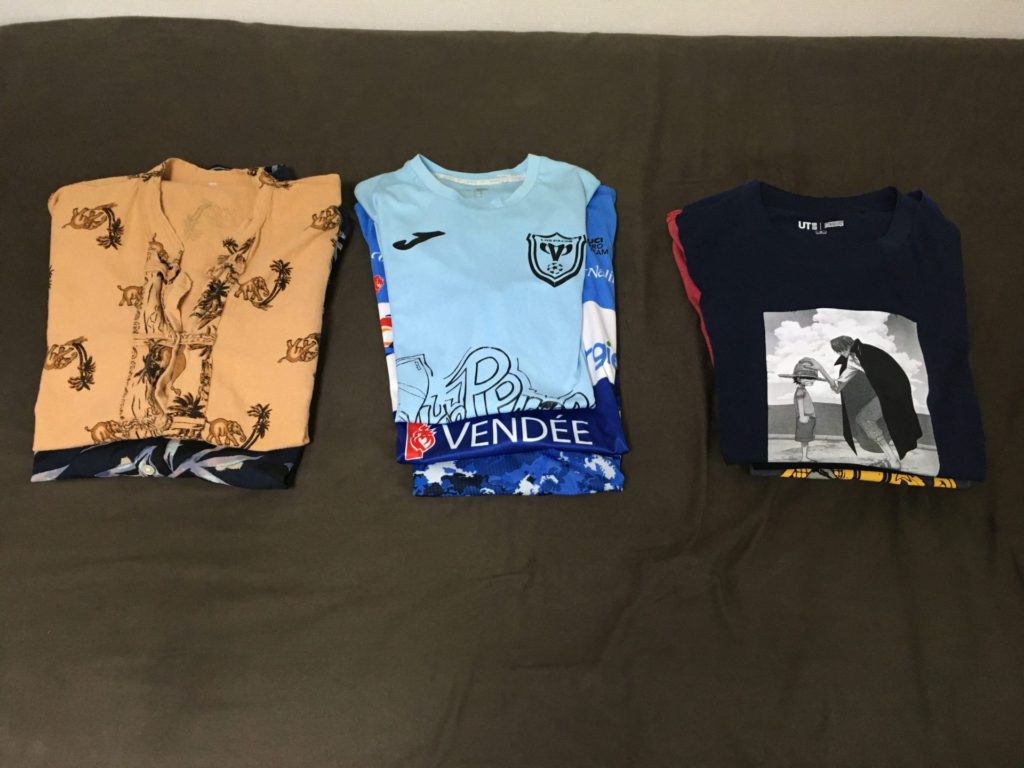
Sleeping wear
Light is the key here, as you have probably noticed already. I’m a very heat-sensitive person so, two shorts and two short sleeve t-shirts are enough for me. Yes, two and two will become your lucky number when deciding what to pack for a year abroad. In your case, you might need long ones. It’s alright, you can either bring some of them or just buy a warmer duvet :). By the way, if you are trying to figure out where I bought that super cool Son Goku’s t-shirt, I didn’t. It was a present from my sister when she was in Japan. But, even if you are not going to Japan any time soon, you can find it here.
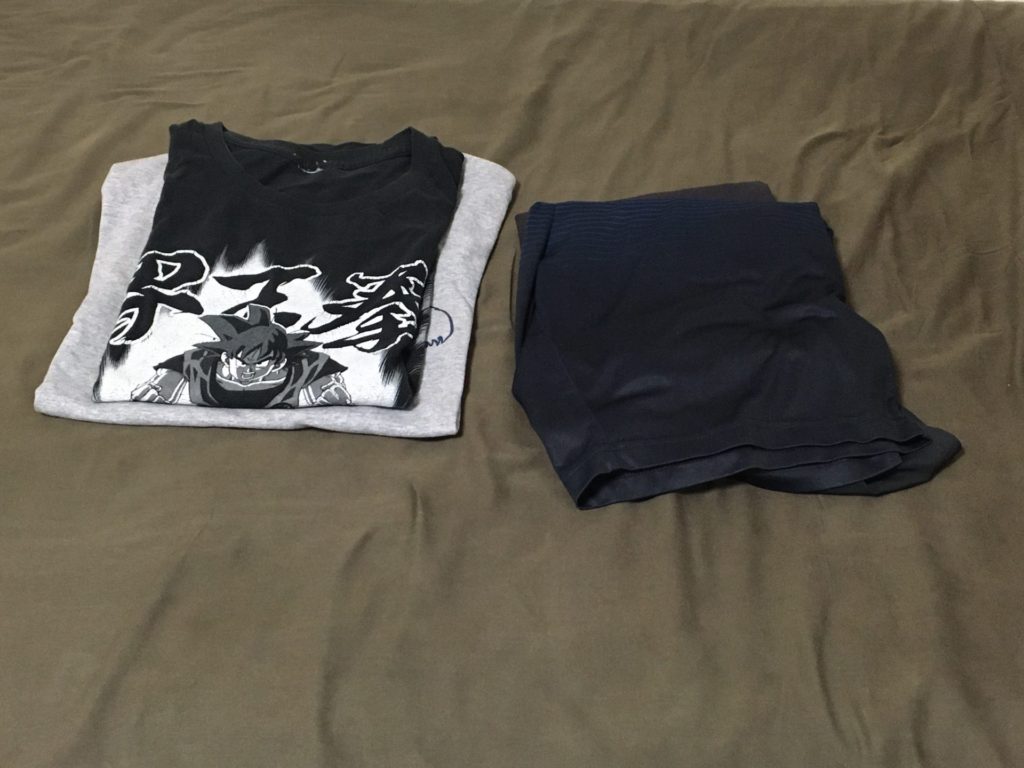
Shoes
Choosing what shoes to pack for a year abroad can be the most Dantesque of all tasks. This time though, I’ll make it easy for you. The magic number here is four: one for running or working out, one for hiking or trekking, one for going out or just sightseeing and one to use when taking a shower or when being at home all day. If you are a girl you might add some high-heels but, please, remember not to overdo it :). If you are a sensitive-to-cold person you might add regular slippers or buy some warm and thick shocks. instead of using the sandals. You are free to play around with your options but, the ones you can see in the picture are the general shoes to take for a year abroad.
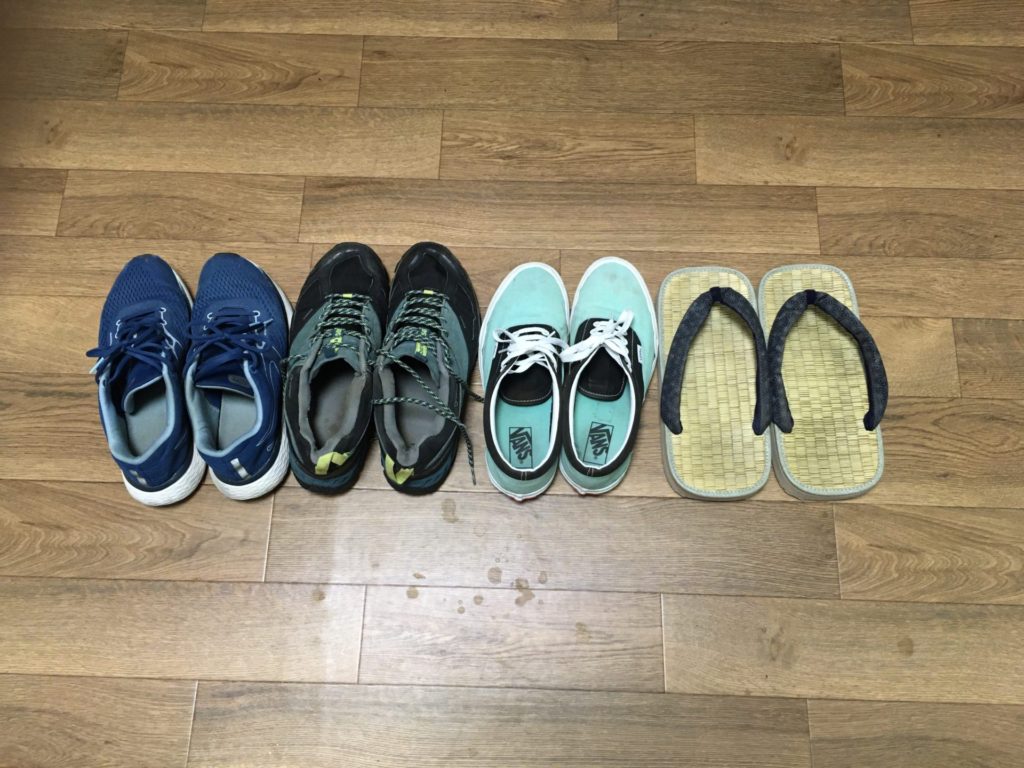
Accessories
What accessories do you need to pack for a year abroad? Sun glasses, cap, towel, water bottle, raincoat and sarong. I already spoke about the super cool Buu cap a few paragraphs above. When it comes to sun glasses, you are free to chose the ones that match your style the best. In my case, I’ve been with the aviator Ray-Ban for some time and I’m very happy with them. For the towel, you have to make a decision here. Either a thick one that really dries your skin or a thin and portable one that doesn’t dry that well but that it gets itself dried very quickly and occupy very little space.
In my case, when travelling for a long time, I go with the Decathlon’s microfiber one. A raincoat will also become one of your best friends, just as a power bank. Specially, if you are going to travel in Japan or Southeast Asia, where all of a sudden a monsoon can take place. In those times, you want to have a raincoat in your bag with you. In order to avoid buying so many plastic bottles and to try to reduce the chances of getting sick from drinking water, you want to have with you a filter water bottle.
After doing some research and running into these two amazing posts (this one and this one), I decided to go with the Brita one. Lastly, to avoid having an unpleasant situation when visiting a temple, you should also bring a sarong with you. When visiting Southeast Asia you will be using it all the time to visit temples and, if you are not in Southeast Asia but in another part of the world, you can also use it to sit down while having that amazing picnic.
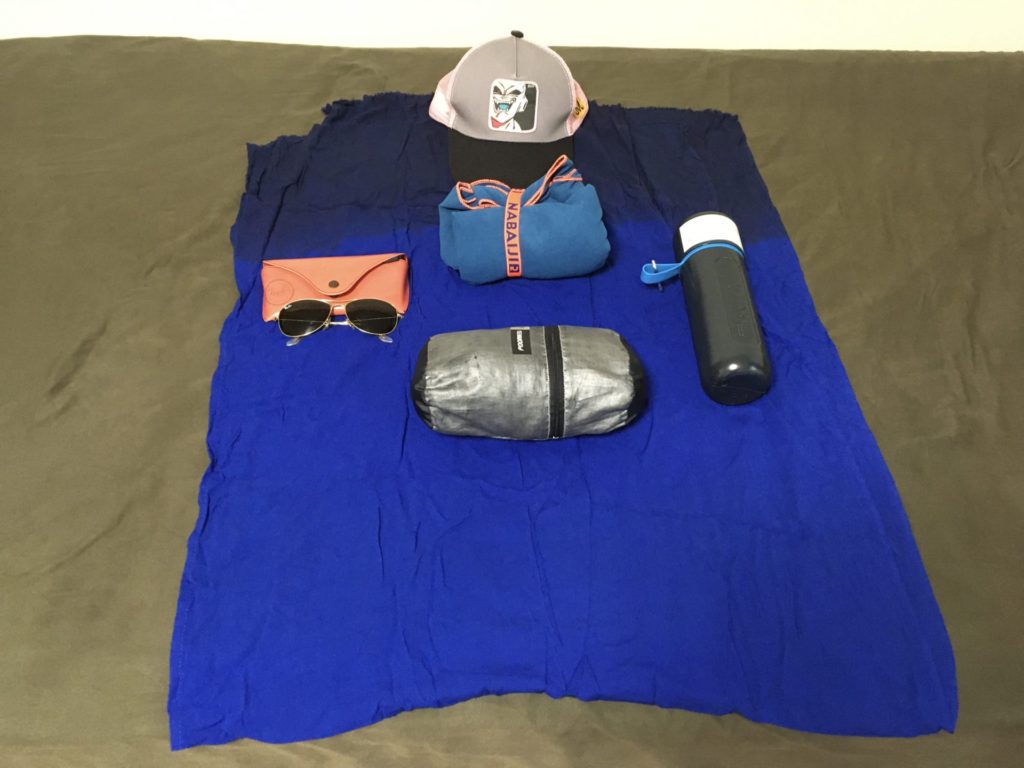
How to pack for a year abroad?
Congratulations! You’ve made it this far! It wasn’t easy, but you finally found the courage to get rid of all those stuff you really don’t need and you selected what it will be accompanying you in your year abroad. You are almost there! But, wait. Now that you have everything you want to take with you in your Work and Holiday or in your Erasmus year on top of your bed, how do you fit all that into your 55 + 10 L backpack and in your carry-on one? In the past, I used to use vacuum bags for clothes. They were really good. You would just put your clothes inside, use a vacuum to extract the air from inside the bag and they would end up flat, compact and… very wrinkled.
Vacuum bags for clothes
Back in the day, when I was doing Erasmus in Linköping, I didn’t mind spending hours trying to iron all those wrinkled clothes so they looked nice. That was back in the day. Now, it’s been years since I used an iron (I’m sorry mom). I just put my clothes in the drier and then hang them in a hanger and, most of the times, it does the trick.
During that year of Erasmus or during that year studying in the University of Irvine (California), I was not travelling that much. Meaning, I was most of the time in a fixed place and, a few times a month, I would go somewhere not far from home. Now, things have changed. For example, in just a few weeks, I’ll be leaving Japan and spending a couple of few weeks in South Korea, a couple of weeks in Borneo and a couple of weeks in Vietnam. With a trip like that in the horizon, should you use vacuum bags to help you pack for your year abroad?
I’m going to be travelling all around those countries and, as you might imagine, I don’t feel like the vacuum bags for clothes are the best solution. That’s my case now. If your scenario is one where you are not going to be travelling that often, then, I advise you to use the vacuum bags. They work really well. If you don’t want to iron your clothes, you can just wash them, dry them and then, put them in hangers.
Rubber bands
If you are like the current version of me and you will be moving around quite often, then, I advise you to use a very simple but effective method to pack for your year abroad: rubber bands. What? Yes, you read well. RUBBER BANDS. How will rubber bands help me pack for a year abroad? Like this:
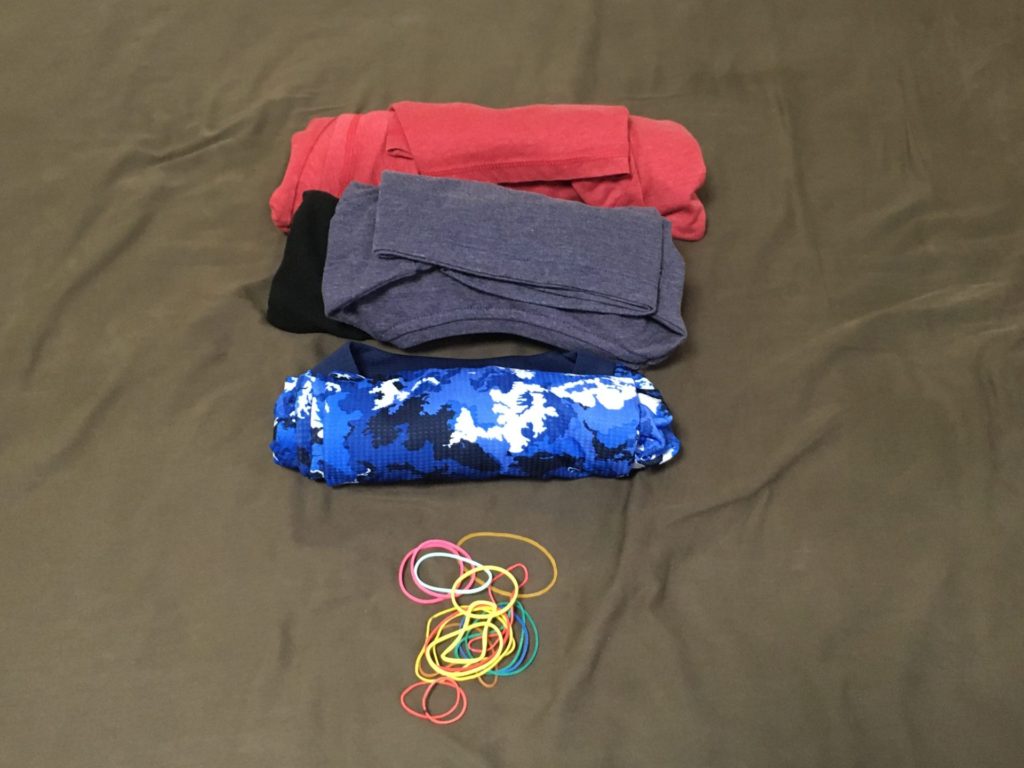
Say you have two sport t-shirts and six regular ones (for going out, staying at home, etc). Pick a pair of them, put one on top of the other, roll them together and tie them up with one of the rubber bands shown in the picture. Do these with matching pairs: sports t-shirts with sports t-shirts, regular ones with regular ones. Like that, not only you will get them organized by type but also you will reduce the space. And, they will not end up as wrinkled as if you had used the vacuum bags for clothes.
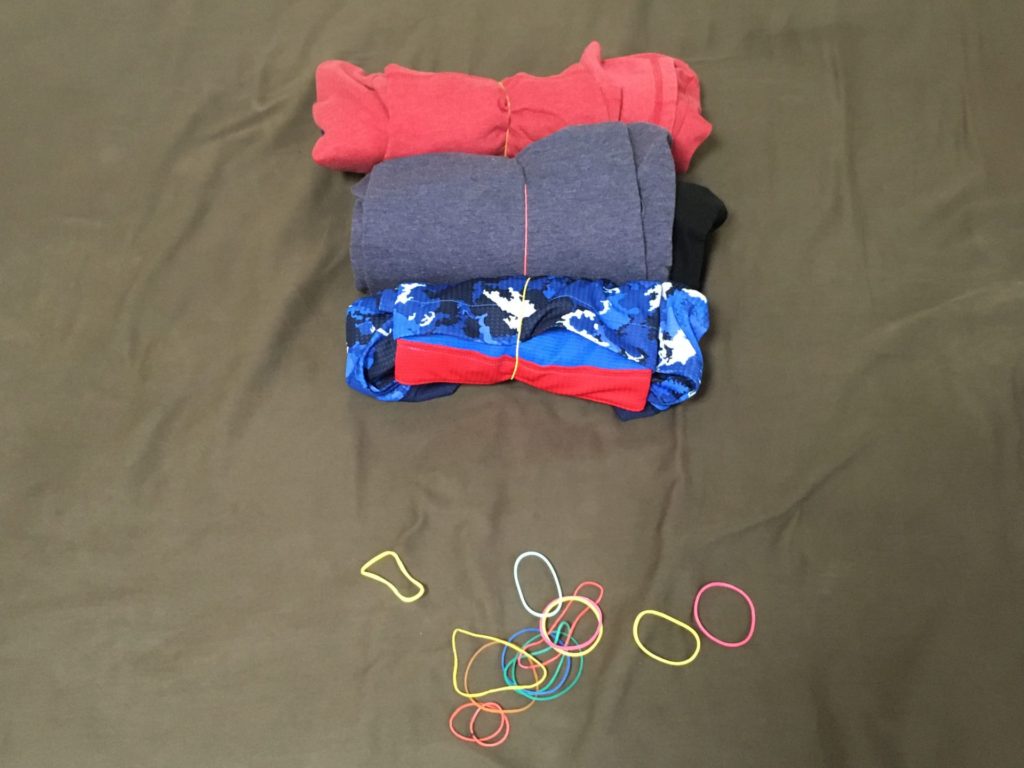
The same applies to your shorts, swimsuits and underwear: separate them in pairs, roll them up together and tie them up with your beautiful and powerful rubber band. Hell yeah! 🙂
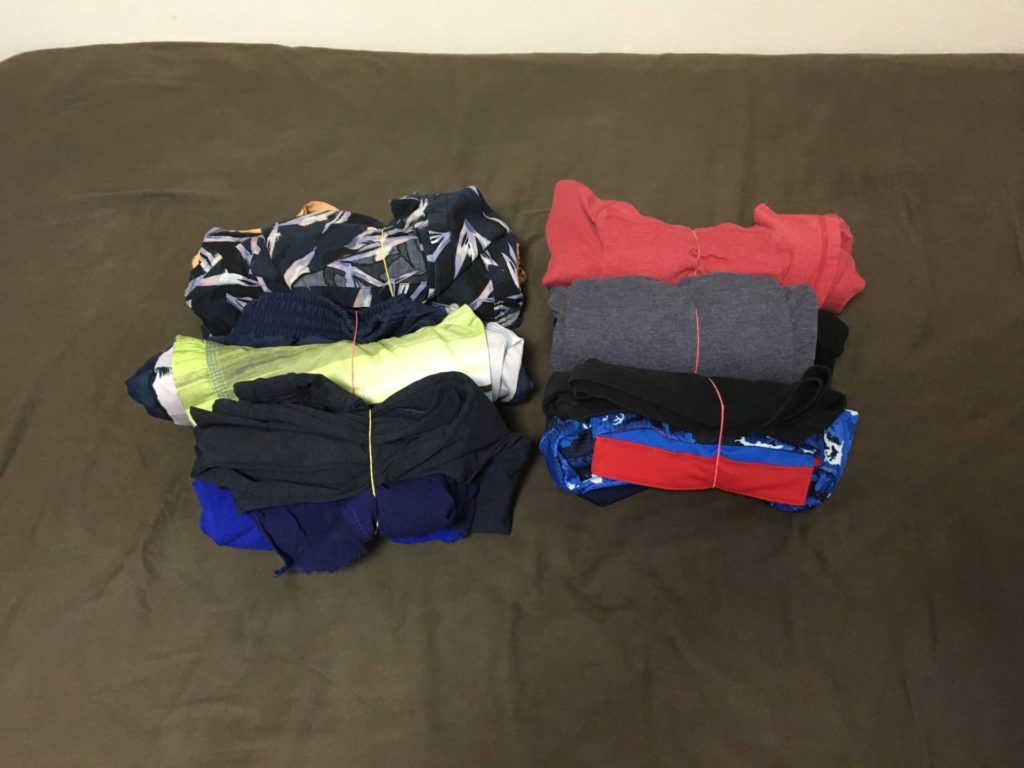
Then, all you need is to place them smartly in your backpack so you know at anytime where the type of clothing you are looking for is. Also, once again, the good thing about organizing everything by pairs is that you can quickly grab one shorts, one shirt and one swimsuit, for example. And if next day you need new and clean ones, you know where the other pair is 😁.
Pro tips
How about shoes? How do you pack your shoes for a year abroad? Depending on the rubber band, you might manage to tie a pair of shoes up but, at some point, the band will break. You can use the same concept but using a regular plastic bag instead of a rubber band. Just put one of the shoes facing up and the other facing down. Join them together, put them in a plastic bag and close this one very tight. For the hiking shoes you can put each one of them inside a bag, pull the shoelace up, close the bag and tie each one of the shoes up with the help of one of the multiple backpack’s straps. It looks like this:

By the way, you don’t have to put the hiking shoes inside bags. I just do it to avoid getting the backpack dirty because of the shoes :).

Once you have everything inside your backpack and the shoes attached to it, you have two steps left before succeeding at packing everything you need for a year abroad. The first one is to put your winter jacket on top of the front of the backpack (covering the whole area from the top to the bottom, including the hiking shoes) and then, tie it up against the back of the backpack. It looks like this:
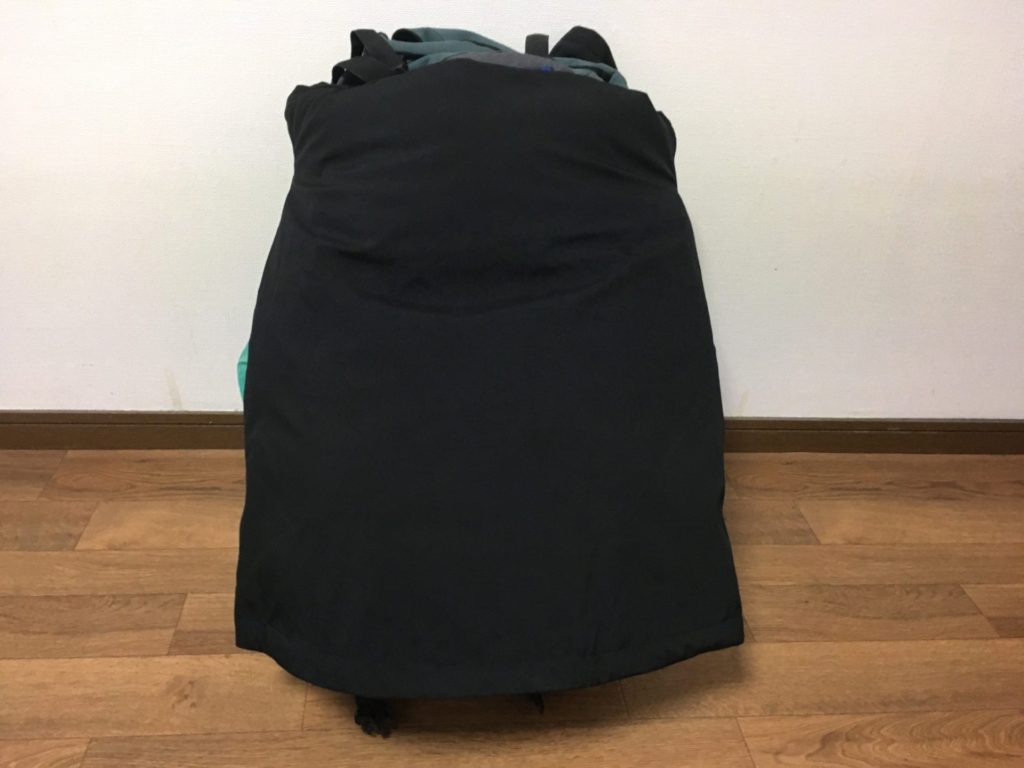
I just spoke about the winter jacket here but, the truth is, I also did the same with the thickest hoodie I had 😉. And… your last step is to cover everything with the rainproof cover so everything is nice, tidy and safe!
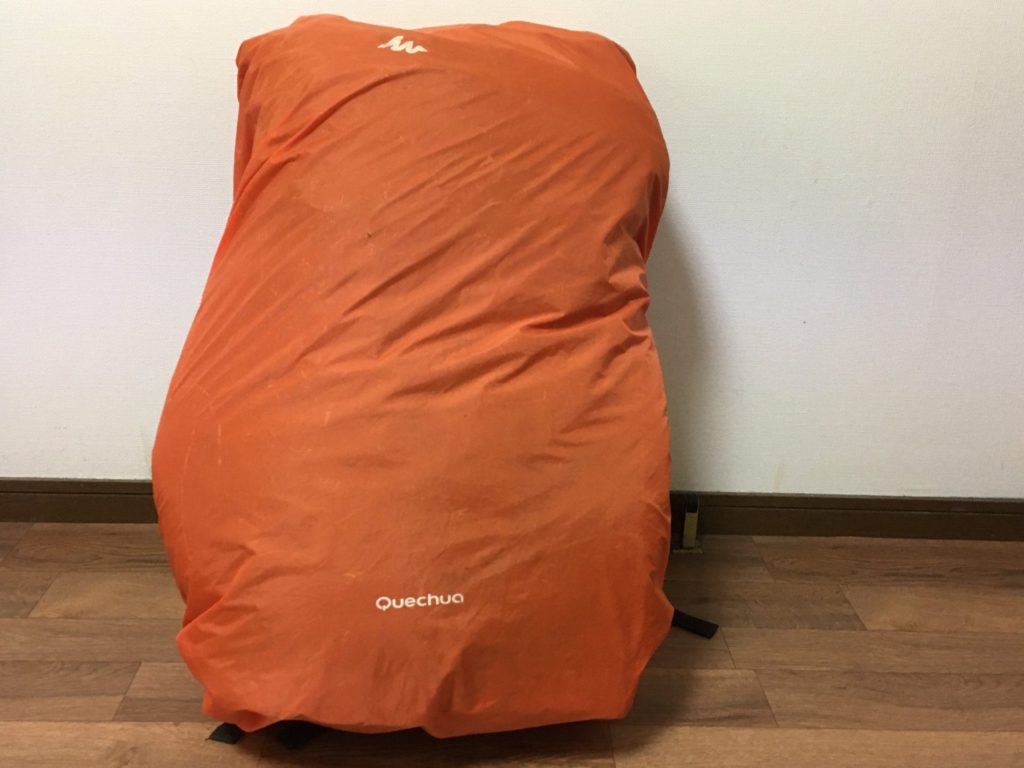
And that’s pretty much all. I assume you know how to get your carry-on backpack ready. You just basically have to place all your electronic devices nice and tightly so they don’t move too much when you are travelling. In case it helps, I usually have all my documents (passport, driving license, etc) organized in a plastic folder, which I place on the back of the backpack, just behind the laptop :).
So, what do you think about the techniques and tricks to pack for a year abroad? Do you have different ways and/or suggestions? I hope you enjoyed the post and, when the moment comes to face the unpleasant experience of what to pack for a year abroad, you look at it with different eyes 😎.
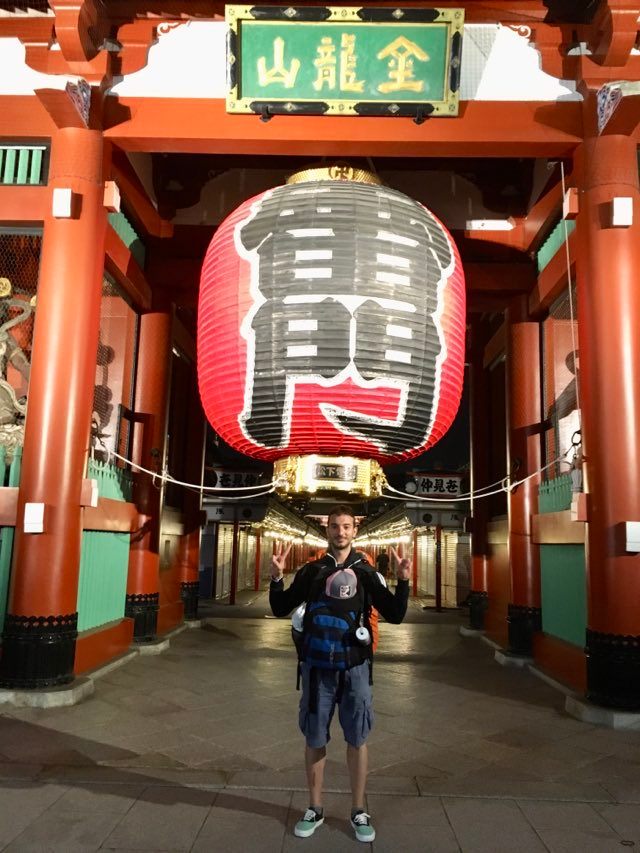



2 Responses
Very useful!! Thanks for the tips!! 😉
Thank you! 🙂